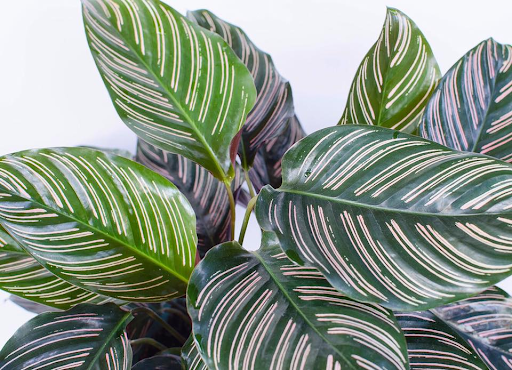Exploring the Calatheas and Bird of Paradise Plant

Within the realm of indoor plants, two captivating species stand out for their unique charm and the ability to transform living spaces into lush sanctuaries – the Calatheas and the Bird of Paradise Plant. As we embark on a journey through the intricate patterns of Calatheas’ leaves and the majestic allure of the Bird of Paradise, we unravel the secrets behind these green companions that bring nature’s beauty indoors.
Calatheas: Nature’s Living Canvas
- Intricate Foliage Patterns
Calatheas, also known as prayer plants, boast a remarkable display of intricate foliage patterns. From the delicate pinstripes of Calathea ornata to the mesmerizing markings of Calathea lancifolia, each species showcases its own unique artwork. The leaves of Calatheas are not merely green; they are canvases adorned with strokes of nature’s creativity, adding a touch of artistic elegance to any interior.
- Responsive Leaves
One of the enchanting features of Calatheas is their responsive leaves, a behavior that has earned them the nickname “prayer plants.” The leaves exhibit a rhythmic opening and closing motion, responding to the daily cycle of light. This characteristic not only adds a dynamic element to their presence but also serves as a visual spectacle, creating a sense of connection between the plant and its environment.
- Suitable for Low-Light Spaces
Calatheas are well-suited for spaces with lower light levels, making them versatile choices for various rooms within a home. While they appreciate indirect sunlight, they thrive in conditions where direct sunlight is filtered or limited. This adaptability enhances their appeal for interior landscapes that may not receive abundant natural light.
- Air-Purifying Prowess
Beyond their aesthetic appeal, Calatheas contribute to a healthier indoor environment by purifying the air. They actively filter out common pollutants, including formaldehyde, benzene, and trichloroethylene. Incorporating Calatheas into your indoor greenery not only adds visual charm but also supports a cleaner and fresher atmosphere.
Bird of Paradise Plant: The Iconic Tropical Marvel
- Majestic Foliage
The Bird of Paradise Plant (Strelitzia reginae) is an iconic tropical marvel celebrated for its majestic foliage that mimics the shape of a bird in flight. Large, banana-like leaves fan out in an architectural display, creating a striking focal point. The plant’s distinct structure adds a touch of the exotic to interior spaces, evoking the feeling of a lush tropical paradise.
- Indoor Statement Plant
As a statement plant, the Bird of Paradise commands attention with its grandeur. It is often chosen to become a centerpiece, standing tall and proud in living rooms, offices, or any space where a bold botanical statement is desired. Its ability to adapt to indoor conditions while maintaining its tropical allure makes it a sought-after choice for plant enthusiasts.
- Tolerant of Indoor Conditions
The Bird of Paradise plant is renowned for its adaptability to indoor conditions. While it thrives in bright, indirect sunlight, it can tolerate lower light levels, making it suitable for spaces with varying light conditions. Its robust nature extends to its ability to withstand occasional neglect, making it an accessible option for those still honing their green thumbs.
- Air-Purifying Qualities
Similar to Calatheas, the Bird of Paradise contributes to indoor air purification. It effectively removes airborne pollutants, enhancing the quality of the air within its surroundings. The combination of its aesthetic appeal and air-purifying qualities positions the Bird of Paradise as a holistic addition to interior landscapes.
Conclusion
In the diverse tapestry of indoor plants, Calatheas and the Bird of Paradise Plant stand as ambassadors of green diversity, each bringing its unique charm and characteristics to indoor landscapes. The intricacies of Calatheas’ foliage patterns and their responsive leaves create an ever-changing visual symphony, while the majestic presence of the Bird of Paradise transports us to tropical realms.


